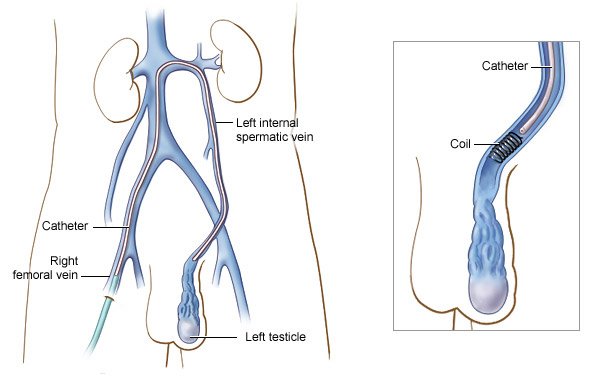Laparoscopic Varicocelectomy
Varicocelectomy is surgery to fix a varicocele. A varicocele is swelling of veins in the scrotum. This swelling is due to blood backing up in the veins. A varicocele can cause pain or a heavy feeling in the scrotum but is often painless. It can also cause problems with fertility. During the surgery, the swollen veins are cut, and the ends are closed off. Other veins in the groin area then take over carrying the blood supply. The surgery may be done with a method called laparoscopy or through open surgery. During laparoscopy, a thin, lighted tube or scope (called a laparoscope) is used. The scope allows the healthcare provider to work through a few small cuts (incisions).

Getting Ready for Surgery
Get ready for the surgery as you’ve been told. In addition:
Tell your healthcare provider about all the medicines you take. This includes prescription medicines and over-the-counter medicines, vitamins, herbs, and other supplements. It also includes any blood thinners, such as warfarin, clopidogrel, or daily aspirin. You may need to stop taking some or all of them before surgery.
Follow any directions you are given for not eating or drinking before surgery. This includes coffee, water, gum, and mints. (If you have been instructed to take medicines, take them with a small sip of water.)
The Day of Surgery
This surgery takes 1 to 2 hours. You’ll likely go home the same day.
Before the surgery begins
An IV (intravenous) line is put into a vein in your arm or hand. This supplies fluids and medicine (such as antibiotics).
You may be given a medicine to prevent blood clots.
To keep you pain-free during the surgery, you’re given general anesthesia. This medicine puts you into a deep sleep-like state during the surgery. A tube may be inserted into your throat to help you breathe.
A thin tube (catheter) is placed in your bladder to drain urine.
During the surgery
The healthcare provider makes a few small incisions in the belly (abdomen).
The scope is placed through one of the incisions. It sends live pictures of the inside of the abdomen to a video screen.
The abdomen is filled with gas. This makes space for the healthcare provider to see and work.
Using tools placed through the other incisions, the swollen veins are cut. The ends may be sealed with tiny clips. Or the ends may be cauterized, which means heat may be used to seal them.
When the surgery is done, all tools are removed. The incisions are closed with stitches or staples.
The healthcare provider will begin with laparoscopy. But they may need to change to open surgery for safety reasons. Open surgery is done using an incision in the abdomen or the groin. You’ll be told more about this possibility before surgery.
After the surgery
You’ll be taken to a recovery room to rest until the anesthesia wears off. You may feel sleepy and nauseated. If a breathing tube was used, your throat might be sore at first. You’ll be given medicines to manage any pain. The catheter will be removed from your bladder. When you’re ready to go home, you’ll be released to an adult family member or friend.
Risks and Possible Complications
Possible risks of this procedure include:
Infection
Bleeding, blood clots
Return of the varicocele
Failure to restore fertility
Fluid around a testicle (hydrocele)
Shrinking (atrophy) of a testicle
Damage to nearby nerves, blood vessels, or organs (including the intestine)
Short-term (temporary) decrease in sperm count
Long-term (chronic) pain
Risks of anesthesia. The anesthesiologist or nurse anesthetist will discuss these with you.
